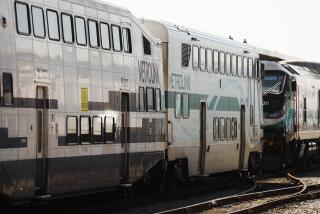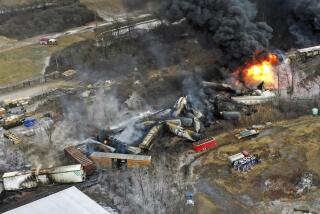7 Killed, 78 Hurt in Amtrak Wreck : Transportation: Part of passenger train hits freight cars when en route from Miami to New York. The cause of the accident has not been determined.
CAMDEN, S.C. — A section of an Amtrak passenger train derailed and slammed into freight cars standing on a side track here Wednesday, killing seven people and injuring 78, authorities said.
The 18-car Silver Star Amtrak train, pulled by two locomotives, was bound for New York from Miami, carrying 426 passengers and a crew of 20.
Eyewitnesses who rushed to the scene found a twisted mass of metal. Entire sections of five passenger cars were ripped open. Six other cars were partly derailed. Passengers said there was no panic as they scrambled out of the wreckage or were rescued.
The accident, which occurred at 5:02 a.m. during a rainstorm, was the latest in a series of train derailments and was the worst for Amtrak since January, 1987, when 16 people were killed in a wreck in Chase, Md.
Seven passengers were killed on the spot Wednesday, according to an Amtrak spokesman here. Earlier in the day, Amtrak officials reported that at least 13 people were killed, but later they revised the figure.
Six of the seven dead were in the last car, which took the brunt of the impact. One of the stationary freight cars, loaded with coal, sand and wood chips, ripped the left side of the rear passenger car on impact, peeling back the car’s aluminum skin for about 25 feet.
Christopher Hart, a member of the National Transportation Safety Board investigating team that arrived here later Wednesday, said the passenger train was going 79 m.p.h., the speed limit at that point.
Hart said that no possible cause was being ruled out, but he noted that the derailment occurred near a mechanism that switches trains from the main track onto a siding. “That certainly makes a switch a suspect,” he said.
He said the locomotive was inspected Tuesday. An initial investigation showed no defects in the train or the engines, Hart said.
Throughout the day, survivors were shuttled to area hospitals, checked for injuries and put aboard buses heading north.
At the Camden High School cafeteria, which was pressed into service as a temporary shelter, some of the survivors, many still dazed, described their ordeal.
William and Gertrude Klausner of Vienna, Austria, both suffered rib injuries. Like many others, they were sleeping just before the derailment.
“The train started to rock. Then there was a large explosion,” William Klausner said in German. “We were thrown around. I saw a very large hole in the side of the train. One young woman was squeezed between the seats, and a young man in front of us died.”
Cora Smith of Chicago, who had spent a week at Disney World in Orlando, Fla., with six family members and was headed home, said she “heard a loud sound. It was as if we were going down an incline. Bump, bump, bump. It seemed as if it would never end.
“Seats were torn up. It was horrible. It seemed like forever,” she said.
Smith added that there was “no panic, no screams. All I could hear was myself shouting.”
The accident happened in an industrial area, near two plants, Du Pont and Kord Corp. At Kord, several employees who were at work when the train derailed described the scene.
Pat Patterson, Kord general manager, rushed to the site, about half a mile from his plant. “They were pulling out two bodies when I got there,” he said. “The car looked like somebody had sawed the thing in half. It was just a mess.”
Local residents said record rainfalls had loosened the soil in the area, and several speculated on whether the train tracks were weakened.
However, at a news conference, John Drake, district manager of CSX Transportation, which owns the track over which the Amtrak train was traveling, said the track was inspected on Tuesday.
He also said the crew was fresh, having begun duty in Jacksonville, Fla. The crew was being tested for drugs, which is standard procedure in accident investigations.
Responding to criticism that rescuers were slow to arrive, Hugh Munn, a spokesman for the South Carolina Law Enforcement Division, said: “They got there very quickly. That may be the reason there were so few fatalities. Of course, when you’re injured, 10 minutes can seem like 10 hours.”
On Sunday, 14 cars of a 42-car Southern Pacific Transportation Co. train jumped the tracks in California, 60 miles northwest of Los Angeles. Another Southern Pacific train derailed July 14, in Northern California, and spilled up to 19,000 gallons of herbicide into the Sacramento River about 250 miles northeast of San Francisco.
More to Read
Sign up for Essential California
The most important California stories and recommendations in your inbox every morning.
You may occasionally receive promotional content from the Los Angeles Times.








